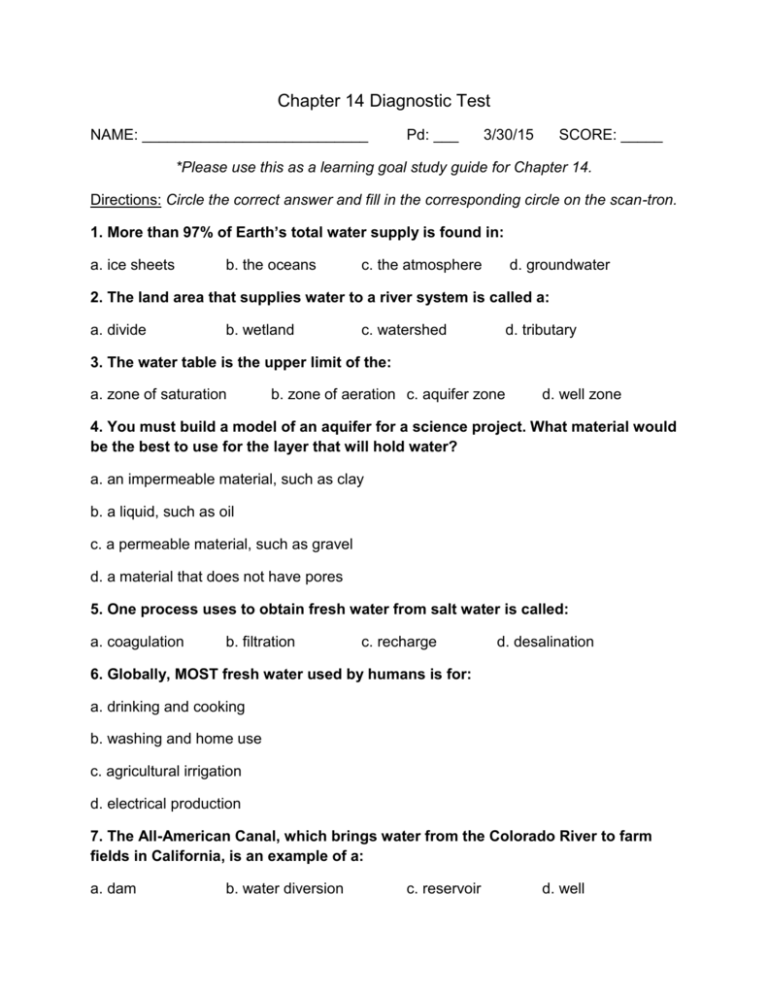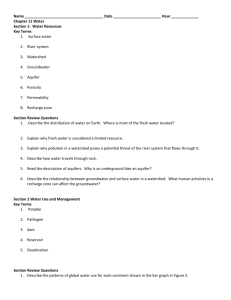Chapter 14 Diagnostic Test
advertisement

Chapter 14 Diagnostic Test NAME: ___________________________ Pd: ___ 3/30/15 SCORE: _____ *Please use this as a learning goal study guide for Chapter 14. Directions: Circle the correct answer and fill in the corresponding circle on the scan-tron. 1. More than 97% of Earth’s total water supply is found in: a. ice sheets b. the oceans c. the atmosphere d. groundwater 2. The land area that supplies water to a river system is called a: a. divide b. wetland c. watershed d. tributary 3. The water table is the upper limit of the: a. zone of saturation b. zone of aeration c. aquifer zone d. well zone 4. You must build a model of an aquifer for a science project. What material would be the best to use for the layer that will hold water? a. an impermeable material, such as clay b. a liquid, such as oil c. a permeable material, such as gravel d. a material that does not have pores 5. One process uses to obtain fresh water from salt water is called: a. coagulation b. filtration c. recharge d. desalination 6. Globally, MOST fresh water used by humans is for: a. drinking and cooking b. washing and home use c. agricultural irrigation d. electrical production 7. The All-American Canal, which brings water from the Colorado River to farm fields in California, is an example of a: a. dam b. water diversion c. reservoir d. well 8. Which of the following does NOT contribute to water conservation? a. drip irrigation b. xeriscaping c. Using a low-flow facets and shower heads d. watering lawns during peak sunlight hours, when plants need water most 9. An oil spill is an example of a. point-source pollution b. nonpoint-source pollution c. reversible pollution d. natural pollution 10. Chlorine is often added during water treatment to a. make particles form clumps b. kill disease-causing organisms c. improve the taste of water d. remove objects such as fish and trash 11. Most fresh water on Earth is: a. frozen b. liquid c. in rivers d. in the atmosphere 12. Water moves through _____________ materials. a. non-permeable b. impermeable c. semi-permeable d. permeable 13. This photo shows a _________ source of pollution. a. point b. non point c. poor d. crude 14. Cultural eutrophication can result from ________ pollution. a. toxic-chemical b. toxic-biological c. nutrient d. nutrition 15. Dams create ________, artificial lakes that humans use for water storage. a. reservoirs b. aquifers c. tributaries d. estuaries 16. The picture below is an example of a ____________ plant. a. power b. desalination c. solar d. nuclear 17. The picture below shows a(n) _______, a type of nutrient pollution that occurs in the ocean. a. red tide b. mercury spill c. oil spill d. algal bloom 18. An oil covered street, an example of _________ pollution. a. point source b. non point source c. air d. soil 19. Water that has been used by people in some way is called: a. desalination b. waste water c. red tide d. none of these 20. When a pathogen makes it way into our water it is known as ________ pollution. a. chemcial b. physical c. biological d. thermal c. fluoride d. sulfates 21. The maincause of groundwater pollution is: a. human activity b. aluminum 22. Making it illegal to to release pollution from a point source without a permit, the ____________ was the single most important law to prevent water pollution. a. Pollution Water Act b. Pollution Water Law c. Clean Water Act d. Chemcial Water Act 23. ________mining turns groundwater into a nonrewable resource. a. Underwater b. Underground c. Groundwater d. Salinization 24. A hole that is dug into an aquifer in order to obtain water is called a __________. a. water table b. well c. recharge zone d. watershed c. Great Basin d. Souris-Red-Rainy 25. In which watershed do we live in? a. Atlantic Slope b. Mississippi River








